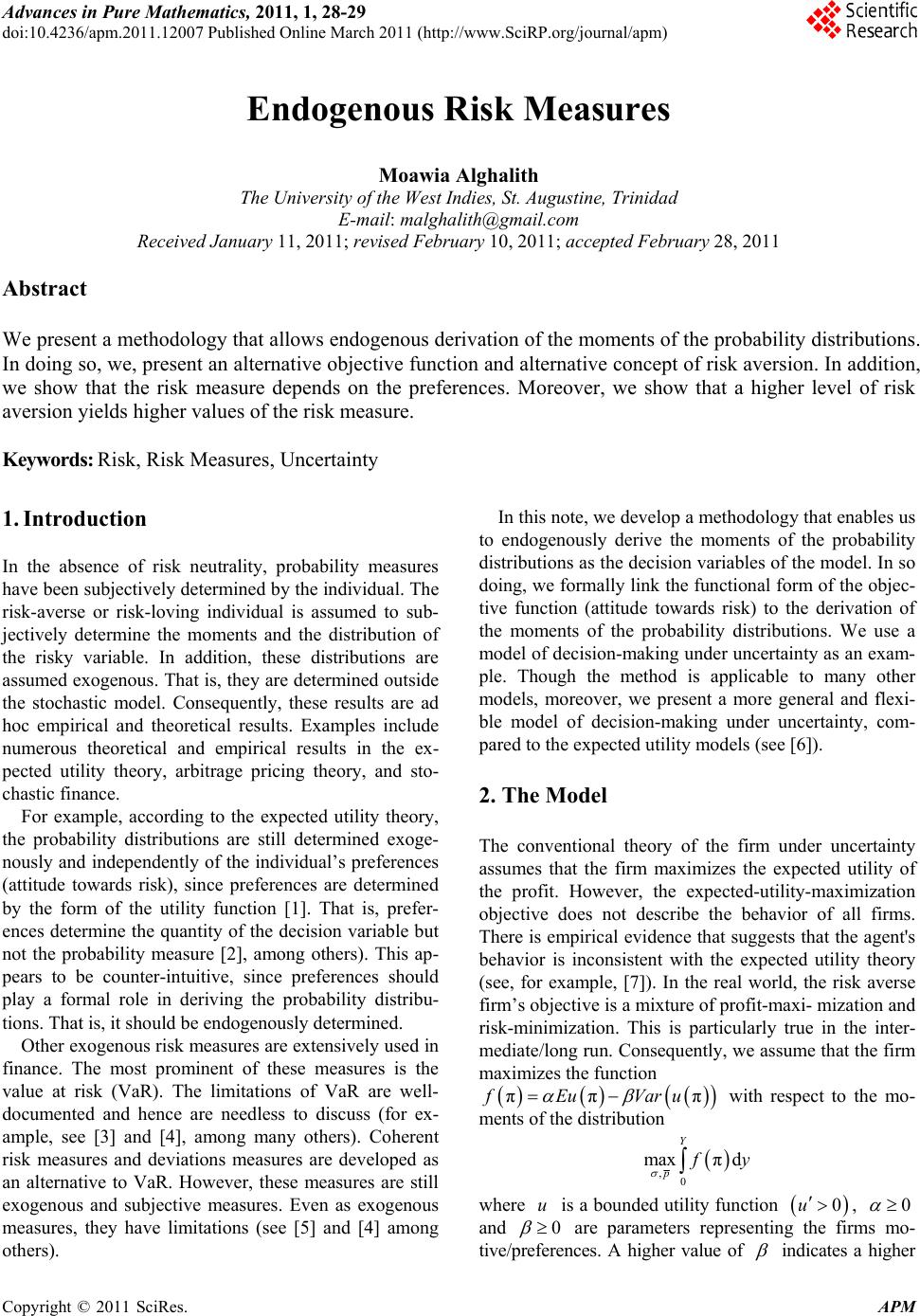
Advances in Pure Mathematics, 2011, 1, 28-29
doi:10.4236/apm.2011.12007 Published Online March 2011 (http://www.SciRP.org/journal/apm)
Copyright © 2011 SciRes. APM
Endogenous Risk Measures
Moawia Alghalith
The University of the West Indies, St. Augustine, Trinidad
E-mail: malghalith@gmail.com
Received January 11, 2011; revised February 10, 2011; accepted February 28, 2011
Abstract
We present a methodology that allows endogenous derivation of the moments of the probability distributions.
In doing so, we, present an alternative objective function and alternative concept of risk aversion. In addition,
we show that the risk measure depends on the preferences. Moreover, we show that a higher level of risk
aversion yields higher values of the risk measure.
Keywords: Risk, Risk Measures, Uncertainty
1. Introduction
In the absence of risk neutrality, probability measures
have been subjectively determined by the individual. The
risk-averse or risk-loving individual is assumed to sub-
jectively determine the moments and the distribution of
the risky variable. In addition, these distributions are
assumed exogenous. That is, they are determined outside
the stochastic model. Consequently, these results are ad
hoc empirical and theoretical results. Examples include
numerous theoretical and empirical results in the ex-
pected utility theory, arbitrage pricing theory, and sto-
chastic finance.
For example, according to the expected utility theory,
the probability distributions are still determined exoge-
nously and independently of the individual’s preferences
(attitude towards risk), since preferences are determined
by the form of the utility function [1]. That is, prefer-
ences determine the quantity of the decision variable but
not the probability measure [2], among others). This ap-
pears to be counter-intuitive, since preferences should
play a formal role in deriving the probability distribu-
tions. That is, it should be endogenously determined.
Other exogenous risk measures are extensively used in
finance. The most prominent of these measures is the
value at risk (VaR). The limitations of VaR are well-
documented and hence are needless to discuss (for ex-
ample, see [3] and [4], among many others). Coherent
risk measures and deviations measures are developed as
an alternative to VaR. However, these measures are still
exogenous and subjective measures. Even as exogenous
measures, they have limitations (see [5] and [4] among
others).
In this note, we develop a methodology that enables us
to endogenously derive the moments of the probability
distributions as the decision variables of the model. In so
doing, we formally link the functional form of the objec-
tive function (attitude towards risk) to the derivation of
the moments of the probability distributions. We use a
model of decision-making under uncertainty as an exam-
ple. Though the method is applicable to many other
models, moreover, we present a more general and flexi-
ble model of decision-making under uncertainty, com-
pared to the expected utility models (see [6]).
2. The Model
The conventional theory of the firm under uncertainty
assumes that the firm maximizes the expected utility of
the profit. However, the expected-utility-maximization
objective does not describe the behavior of all firms.
There is empirical evidence that suggests that the agent's
behavior is inconsistent with the expected utility theory
(see, for example, [7]). In the real world, the risk averse
firm’s objective is a mixture of profit-maxi- mization and
risk-minimization. This is particularly true in the inter-
mediate/long run. Consequently, we assume that the firm
maximizes the function
ππ πfEuVaru
with respect to the mo-
ments of the distribution
,0
max πd
Y
p
y
where u is a bounded utility function
0u, 0
and 0
are parameters representing the firms mo-
tive/preferences. A higher value of
indicates a higher